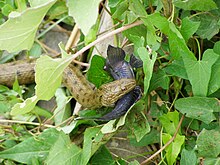Post It On KidzTalk Homework Help
Report a search problem
mobile version
Copyright 2005-2024 KidzSearch.com

|
| Dice snake | |
|---|---|
 | |
| Conservation status | |
| Scientific classification | |
| Kingdom: | |
| Phylum: | |
| Class: | |
| Order: | |
| Suborder: | |
| Family: | |
| Genus: | |
| Species: | N. tessellata |
| Binomial name | |
| Natrix tessellata (Laurenti, 1768) | |
 | |
| Distribution of the Natrix tessellata | |
The Dice snake (Natrix tessellata) is a European non-venomous snake belonging to the family of Colubridae, subfamily Natricinae.
The Dice snake lives a lot in eastern Europe and western Asia, though not as much as the grass snake. Only one species, N.t.heinrothi, is recognized, from the island of Serpilor (Osrov Zminyi) in the Black Sea. Dice snakes are better in water and they have a more slender body. They are mostly able to see easily in a woodland or desert, and sometimes in mountain streams. They usually eat fish, and sometimes they may also eat amphibians. The dice snake is a bit shy. They may grow up to 90 cm long, and has a brown or grey colouring. Although Dice snakes can be seen in Asia, they do not live a lot on Crete. Dice snakes do not have any venom. They can let out a very bad smell, however, for defense. Another thing they use for defending themselves is playing dead. Dice snakes go into dry holes next to the water, and sleep from October to April. This is called hibernating. view more...